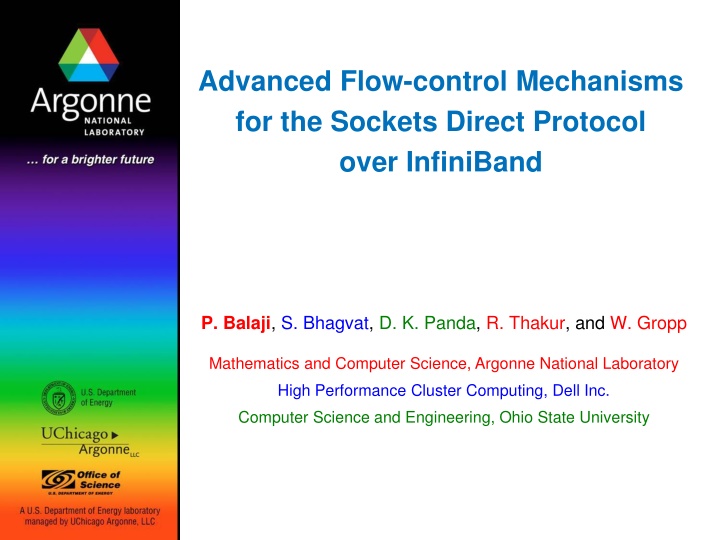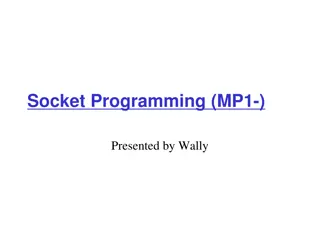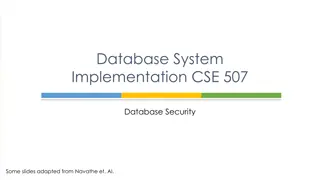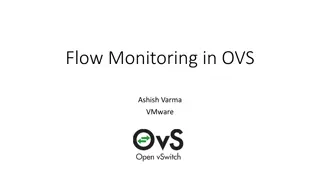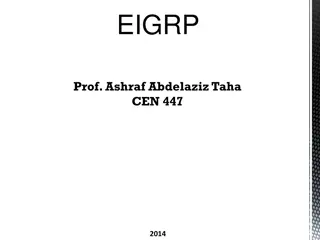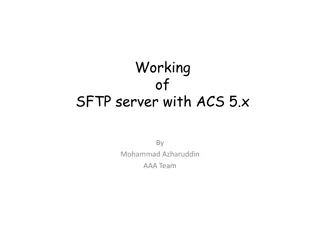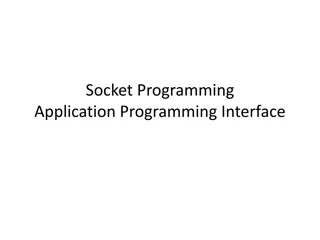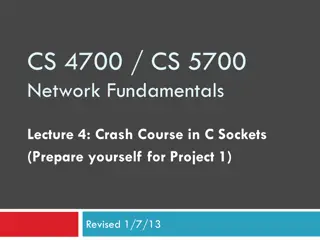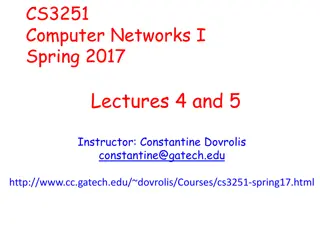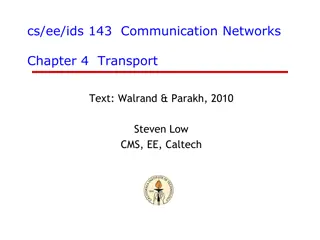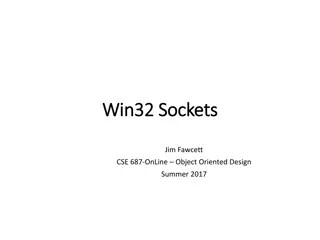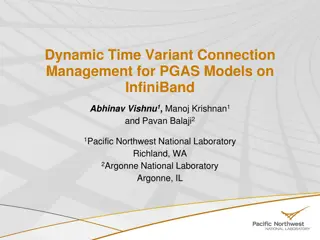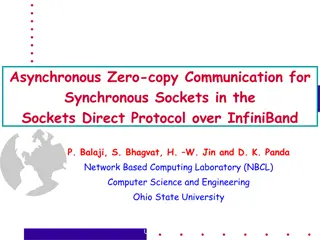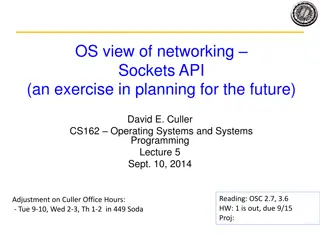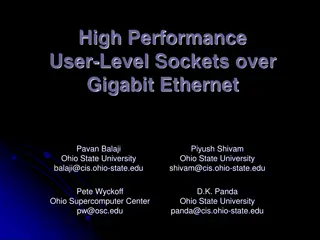Advanced Flow Control Mechanisms for Sockets Direct Protocol over InfiniBand
Discussing the benefits of InfiniBand technology in high-speed networking, challenges TCP/IP faces in utilizing network features properly, and the implementation of Sockets Direct Protocol (SDP) to enhance network performance and capabilities, with a focus on advanced flow control techniques using RDMA and hardware flow control.
Download Presentation

Please find below an Image/Link to download the presentation.
The content on the website is provided AS IS for your information and personal use only. It may not be sold, licensed, or shared on other websites without obtaining consent from the author.If you encounter any issues during the download, it is possible that the publisher has removed the file from their server.
You are allowed to download the files provided on this website for personal or commercial use, subject to the condition that they are used lawfully. All files are the property of their respective owners.
The content on the website is provided AS IS for your information and personal use only. It may not be sold, licensed, or shared on other websites without obtaining consent from the author.
E N D
Presentation Transcript
Advanced Flow-control Mechanisms for the Sockets Direct Protocol over InfiniBand P. Balaji, S. Bhagvat, D. K. Panda, R. Thakur, and W. Gropp Mathematics and Computer Science, Argonne National Laboratory High Performance Cluster Computing, Dell Inc. Computer Science and Engineering, Ohio State University
High-speed Networking with InfiniBand High-speed Networks A significant driving force for ultra-large scale systems High performance and scalability are key InfiniBand is a popular choice as a high-speed network What does InfiniBand provide? High raw performance (low latency and high bandwidth) Rich features and capabilities Hardware offloaded protocol stack (data integrity, reliability, routing) Zero-copy communication (memory-to-memory) Remote direct memory access (read/write data to remote memory) Hardware flow-control (sender ensures receiver is not overrun) Atomic operations, multicast, QoS and several others
TCP/IP on High-speed Networks TCP/IP unable to keep pace with high-speed networks Implemented purely in software (hardware TCP/IP incompatible) Utilizes the raw network capability (e.g., faster network link) Performance limited by the TCP/IP stack On a 16Gbps network, TCP/IP achieves 2-3 Gbps Reason: Does NOT fully utilize network features Hardware offloaded protocol stack RDMA operations Hardware flow-control Advanced features of InfiniBand Great for new applications! How should existing TCP/IP applications use them?
Sockets Direct Protocol (SDP) Industry standard high- performance sockets Sockets Applications or Libraries Sockets Defined for two purposes: TCP Sockets Direct Protocol (SDP) Maintain compatibility for existing applications IP Device Driver Deliver the performance of networks to the applications Advanced Features Offloaded Protocol High-speed Network Many implementations: OSU, OpenFabrics, Mellanox, Voltaire SDP allows applications to utilize the network performance and capabilities with ZERO modifications
SDP State-of-Art SDP standard specifies different communication designs Large Messages: Synchronous Zero-copy design using RDMA Small Messages: Buffer-copy design with credit-based flow-control using send-recv operations These designs are often times not the best ! Previously, we proposed Asynchronous Zero-copy SDP to improve the performance of large messages [balaji07:azsdp] In this paper, we propose new flow-control techniques Utilizing RDMA and hardware flow-control Improve the performance of small messages [balaji07:azsdp] Asynchronous Zero-copy Communication for Synchronous Sockets in the Sockets Direct Protocol over InfiniBand . P. Balaji, S. Bhagvat, H. W. Jin and D. K. Panda. Workshop on Communication Archictecture for Clusters (CAC), with IPDPS 2007.
Presentation Layout Introduction Existing Credit-based Flow-control design RDMA-based Flow-control NIC-assisted RDMA-based Flow-control Experimental Evaluation Conclusions and Future Work
Credit-based Flow-control Flow-control needed to ensure sender does not overrun the receiver Popular flow-control for many programming models SDP, MPI (MPICH2, OpenMPI), File-systems (PVFS2, Lustre) Generic to many networks does not utilize many exotic features TCP/IP like behavior Receiver presents N credits; ensures buffering for N segments Sender sends N message segments before waiting for an ACK When receiver application reads out data and receive buffer is free, an acknowledgment is sent out SDP credit-based flow-control uses static compile-time decided credits (unlike TCP/IP)
Credit-based Flow-control Sender Receiver Application Buffer Application Buffer ACK Credits = 4 Sockets Buffers Sockets Buffers Receiver has to pre-specify buffers in which data should be received InfiniBand requirement for Send-receive communication Sender manages send buffers and receiver manages receive buffers Coordination between sender-receiver through explicit acknowledgments
Limitations with Credit-based Flow-control Sender Receiver Application Buffers Not Posted Application Buffer Application Buffers ACK Sockets Buffers Sockets Buffers Credits = 4 Receiver controls buffers Statically sized temporary buffers Two primary disadvantages: Inefficient resource usage excessive wastage of buffers Small messages pushed directly to network Network performance is under-utilized for small messages
Presentation Layout Introduction Existing Credit-based Flow-control design RDMA-based Flow-control NIC-assisted RDMA-based Flow-control Experimental Evaluation Conclusions and Future Work
InfiniBand RDMA capabilities Remote Direct Memory Access Receiver transparent data placement can help provide a shared-memory like illusion Sender-side buffer management sender can dictate which position in the receive buffer the data should be placed RDMA with Immediate-data Requires receiver to explicitly check for the receipt of data Allows receiver to know when the data has arrived Loses receiver transparency! Still retains sender-side buffer management In this design, we utilize RDMA with immediate data
RDMA-based Flow-control Utilizes InfiniBand RDMA with Immediate Data feature Sender side buffer management Avoids buffer wastage for small-medium messages Uses an immediate send threshold to improve the throughput for small-medium messages using message coalescing Sender Receiver Application Buffers Not Posted Application Buffer Application Buffers ACK Sockets Buffers Sockets Buffers Immediate Send Threshold = 4
Limitations of RDMA-based Flow-control Sender Receiver Application Application Buffers Not Posted Application Buffer Application Buffers is computing ACK Sockets Buffers Sockets Buffers Immediate Send Threshold = 4 Remote credits are available, data is present in sockets buffer Communication progress does not take place
Presentation Layout Introduction Existing Credit-based Flow-control design RDMA-based Flow-control NIC-assisted RDMA-based Flow-control Experimental Evaluation Conclusions and Future Work
Hardware vs. Software Flow-control InfiniBand hardware provides a na ve message level flow control mechanism Guarantees that a message is not sent out till the receiver is ready Hardware takes care of progress even if application is busy with other computation Does not guarantee that the receiver has posted a sufficiently large buffer buffer overruns are errors! Does not provide message coalescing capabilities Software Flow control schemes are more intelligent Message coalescing, segmentation and reassembly No progress if application is busy with other computation
NIC-assisted RDMA-based Flow-control NIC-Assisted Flow Control Hybrid Hardware/Software Takes the best of IB hardware flow-control and the software features of RDMA-based flow-control Contains two main mechanisms: Virtual window mechanism Mainly for correctness avoid buffer overflows Asynchronous interrupt mechanism Enhancement to virtual window mechanism Improves performance by coalescing data
Virtual Window Mechanism For a virtual window size of W, the receiver posts N/W work queue entries, i.e., it is ready to receive N/W messages Sender always sends message segments smaller than W The first N/W messages are directly transmitted by the NIC The later send requests are queued by the hardware Sender Receiver Application Application Buffers Not Posted Application Buffer Application Buffers is computing NIC-handled Buffers ACK Sockets Buffers Sockets Buffers N / W = 4
Asynchronous Interrupt Mechanism After the NIC gives the interrupt, it still has some messages to send allows us to effectively utilize the interrupt time without wasting it We can coalesce small amounts of data sufficient to reach the performance of RDMA-based flow control Sender Receiver Application Application Buffers Not Posted Application Buffer Application Buffers is computing Software handled Buffers ACK Sockets Buffers Sockets Buffers IB Interrupt N / W = 4
Presentation Layout Introduction Existing Credit-based Flow-control design RDMA-based Flow-control NIC-assisted RDMA-based Flow-control Experimental Evaluation Conclusions and Future Work
Experimental Testbed 16-node cluster Dual Intel Xeon 3.6GHz EM64T processors (single core, dual- processor) Each processor has 2MB L2 cache The system has 1GB of 533MHz DDR SDRAM Connected using Mellanox MT25208 InfiniBand DDR adapters (3rd generation adapters) Mellanox MTS-2400 24-port fully non-blocking switch
SDP Latency and Bandwidth SDP Latency SDP Bandwidth 7000 35 Credit-based Credit-based 6000 RDMA-based 30 RDMA-based NIC-assisted NIC-assisted 5000 25 Bandwidth (Mbps) Latency (us) 4000 20 3000 15 2000 10 1000 5 0 0 1 8 64 Message Size (bytes) 512 4K 32K 256K 1 4 16 64 256 1K 4K Message Size (bytes) RDMA-based and NIC-assisted flow-control designs outperform credit-based flow-control by almost 10X for some message sizes
SDP Buffer Utilization SDP Buffer Usage (256KB buffers) SDP Buffer Usage (8KB buffers) 100 100 Credit-based 90 90 RDMA-based 80 80 NIC-assisted 70 70 Percentage Usage Percentage Usage 60 60 Credit-based RDMA-based 50 50 NIC-assisted 40 40 30 30 20 20 10 10 0 0 1 4 16 Message size (bytes) 64 256 1K 4K 1 4 16 Message size (bytes) 64 256 1K 4K RDMA-based and NIC-assisted flow-control designs utilize the SDP buffers in a much better manner, which eventually leads to their better performance
Communication Progress SDP Communication Progress 8000 7000 Credit-based RDMA-based 6000 NIC-assisted Computation 5000 Latency (us) 4000 3000 2000 1000 0 0 400 800 1200 1600 Good Bad Delay (us) communication Progress communication Progress
Data-cutter Library Component Framework for Combined Task/Data Parallelism Developed by U. Maryland Popular model for data-intensive applications User defines sequence of pipelined components (filters and filter groups) Data parallelism Stream based communication User tells the runtime system to generate/instantiate copies of filters Task parallelism Flow control between filter copies Transparent: single stream illusion E0 Ra0 R0 host3 EK R1 host1 Ra1 M host1 host4 host1 EK+1 R2 Cluster 3 Ra2 host2 EN host5 host2 Cluster 1 Cluster 2 Virtual Microscope Application
Evaluating the Data-cutter Library Virtual Microscope Iso-surface Visual Rendering 5 800 Credit-based 4.5 Credit-based 700 RDMA-based 4 RDMA-based NIC-assisted 600 NIC-assisted 3.5 Execution Time (s) Execution Time (s) 500 3 2.5 400 2 300 1.5 200 1 100 0.5 0 0 512 1024 Dataset dimensions 2048 4096 1024 2048 Dataset dimensions 4096 8192 RDMA-based and NIC-assisted flow-control designs achieve about 10-15% better performance No difference between RDMA-based and NIC-assisted designs application makes regular progress
Presentation Layout Introduction Existing Credit-based Flow-control design RDMA-based Flow-control NIC-assisted RDMA-based Flow-control Experimental Evaluation Conclusions and Future Work
Conclusions and Future Work SDP is an industry standard to allow sockets applications to transparently utilize the performance and features of IB Previous designs allow SDP to utilize some of the features of IB Capabilities of features such as hardware flow-control and RDMA for small messages have not been studied so far In this paper we present two flow-control mechanisms which utilizes these features of IB Shown that our designs can improve performance by up to 10X in some cases Future Work: Integrate our designs in the OpenFabrics SDP implementation. Study MPI flow-control techniques.
Thank You ! Contacts: P. Balaji: balaji@mcs.anl.gov S. Bhagvat: sitha_bhagvat@dell.com D. K. Panda: panda@cse.ohio-state.edu R. Thakur: thakur@mcs.anl.gov W. Gropp: gropp@mcs.anl.gov Web links: http://www.mcs.anl.gov/~balaji http://nowlab.cse.ohio-state.edu
